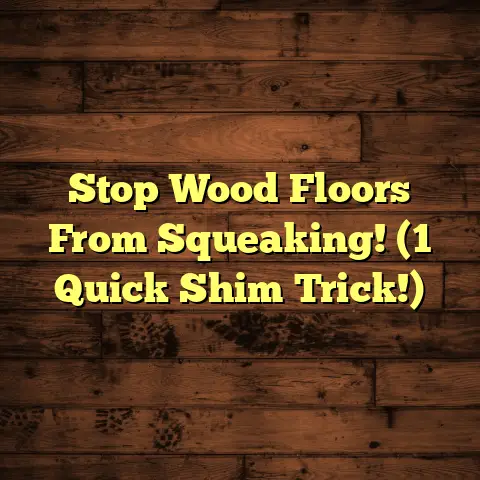Cleats For 3/4 Hardwood? (1 Size Matters!)
I’m excited to talk to you about something that’s absolutely crucial for a successful 3/4-inch hardwood installation: cleats.
Over my years as a flooring contractor, I’ve seen firsthand how the right cleat can make or break a hardwood floor.
The flooring and construction industries have seen some wild innovations, right?
New materials, better tools, and fastening systems that are light years ahead of what we used even a decade ago.
These advancements give us more choices than ever when it comes to flooring.
But with all these choices, it’s easy to overlook the fundamentals.
That’s where cleats come in.
They are the unsung heroes of hardwood flooring, especially for 3/4-inch planks.
Think of them as the glue that holds everything together, literally and figuratively.
Choosing the right size cleat?
It’s not just a detail; it’s the foundation of a durable, stable, and beautiful floor.
Trust me, I’ve seen what happens when you get it wrong.
So, let’s dive into the world of cleats and unlock the secrets to a perfect hardwood floor.
Section 1: Understanding Hardwood Flooring
Okay, let’s start with the basics:
What exactly is 3/4-inch hardwood?
It’s pretty much the gold standard for hardwood flooring.
That thickness provides a solid, substantial feel underfoot, and it’s used everywhere.
From cozy homes to bustling commercial spaces, you’ll find 3/4-inch hardwood adding warmth and elegance.
Why Hardwood is King
There’s a reason why hardwood has been a popular choice for centuries.
It’s tough as nails, gorgeous to look at, and if you take care of it, it’ll last for generations.
- Durability: Hardwood can withstand a lot of foot traffic, kids playing, and even the occasional pet mishap.
- Aesthetic Appeal: The natural grain patterns and rich colors of hardwood add character and sophistication to any room.
- Longevity: Unlike carpet or laminate, hardwood can be refinished multiple times, extending its lifespan for decades.
The Species Game
Now, not all hardwood is created equal.
Different species have different properties, which can affect how they’re installed.
Here are a few common types you’ll see in 3/4-inch flooring:
- Oak: This is your workhorse. It’s affordable, readily available, and takes stain beautifully.
- Maple: Known for its light color and smooth grain, maple is a popular choice for modern homes.
- Hickory: This is one of the hardest domestic hardwoods, making it incredibly durable.
- Brazilian Cherry (Jatoba): An exotic option with a rich, reddish-brown color and exceptional hardness.
The species of wood you choose will affect things like how easily it dents, how well it holds fasteners, and how much it expands and contracts with changes in humidity.
Keep that in mind as we move on to cleats.
Section 2: The Role of Cleats in Hardwood Installation
Alright, let’s get down to the nitty-gritty:
What are cleats, and why are they so important?
Simply put, cleats are specialized fasteners designed specifically for hardwood flooring.
They’re like tiny metal staples with a unique “L” shape that allows them to grip the wood fibers tightly.
Cleats vs. Staples vs. Nails
You might be wondering, “Why not just use staples or nails?”
Well, here’s the deal:
- Staples: They’re cheaper and faster
to install, but they don’t have the same
holding power as cleats.
They can also damage the wood if they’re not installed perfectly. - Nails: Similar to staples, nails can be prone to loosening over time, leading to squeaks and movement in the floor.
Cleats, on the other hand, are designed to move with the wood as it expands and contracts.
This is crucial for preventing problems down the road.
How Cleats Work Their Magic
The secret to cleat’s effectiveness lies in its design.
The “L” shape allows it to be driven in at a 45-degree angle through the tongue of the hardwood plank.
This creates a secure, interlocking connection between the plank and the subfloor.
The length of the cleat is also important.
It needs to be long enough to penetrate deeply into the subfloor, but not so long that it protrudes through the other side.
Cleats are typically made of hardened steel or aluminum, which provides excellent strength and corrosion resistance.
The Benefits of Cleats
So, why should you choose cleats for your 3/4-inch hardwood floor?
Here are a few key advantages:
- Superior Holding Power: Cleats provide a much stronger grip than staples or nails, reducing the risk of movement and squeaks.
- Ease of Installation: Cleats are designed to be installed with a pneumatic nailer, which makes the process quick and efficient.
- Resistance to Movement and Warping: By allowing the wood to expand and contract naturally, cleats help prevent warping, cupping, and other common hardwood flooring problems.
In my experience, using cleats is always worth the investment.
It’s like buying insurance for your floor.
You might not need it right away, but you’ll be glad you have it when problems arise.
Section 3: Size Matters – Choosing the Right Cleat
Okay, this is where things get really important:
Choosing the right cleat size.
I can’t stress this enough:
Size matters!
Using the wrong size cleat is like wearing shoes that are too big or too small.
It’s uncomfortable, and it can lead to problems.
The Goldilocks Principle of Cleats
You need a cleat that’s just right.
Too short, and it won’t penetrate deeply enough into the subfloor, resulting in a weak connection.
Too long, and it could protrude through the subfloor or even damage the hardwood plank.
Factors to Consider
So, how do you determine the right cleat size?
Here are the key factors to consider:
- Hardwood Thickness: This is the most
obvious factor.
You’re working with 3/4-inch hardwood, so that’s your starting point. - Subfloor Type: The type of subfloor
you have will affect how deeply the cleat
needs to penetrate.
Plywood, OSB, and concrete all have different densities and holding power. - Environmental Conditions: In areas with
high humidity, hardwood is more likely to
expand and contract.
You may need a slightly longer cleat to compensate for this movement.
General Guidelines
As a general rule, I recommend using a 1 1/2-inch to 2-inch cleat for 3/4-inch hardwood flooring installed over a wood subfloor.
However, it’s always best to consult the manufacturer’s recommendations for your specific flooring product.
They’ll have the most accurate information based on their testing and experience.
Pro Tip: Always test a few cleats in an inconspicuous area before you start the main installation.
This will allow you to verify that the size is correct and that the cleats are penetrating the subfloor properly.
Real-World Examples
I’ve seen firsthand the consequences of using the wrong cleat size.
I once worked on a project where the installer used cleats that were too short for the subfloor.
Within a few months, the floor started to squeak and move.
We had to tear up the entire floor and reinstall it with the correct size cleats.
It was a costly and time-consuming mistake that could have been easily avoided.
On the other hand, I’ve also seen projects where the installer used the perfect cleat size.
Those floors were rock solid and remained beautiful for years.
The difference is night and day.
Section 4: Installation Techniques for 3/4 Hardwood Flooring with Cleats
Alright, let’s talk about how to actually install 3/4-inch hardwood flooring using cleats.
Here’s a step-by-step guide to help you get the job done right:
- Prepare the Subfloor: Make sure the
subfloor is clean, dry, and level.
Any imperfections can telegraph through to the finished floor. - Install Underlayment (Optional): An underlayment can help reduce noise, provide a moisture barrier, and cushion the floor.
- Establish a Starting Point: Choose a straight wall and lay out the first row of planks, leaving a 1/4-inch expansion gap along the wall.
- Begin Nailing: Using a pneumatic
cleat nailer, drive cleats through the
tongue of each plank at a 45-degree angle.
Maintain consistent spacing between cleats (typically 6-8 inches). - Continue Installing: Work your way across the room, staggering the end joints of the planks for a more visually appealing and structurally sound floor.
- Cut Around Obstacles: Use a saw to cut planks to fit around door frames, pipes, and other obstacles.
- Install the Final Row: You may need to face-nail the final row of planks if you can’t get the cleat nailer close enough to the wall.
- Install Baseboards and Trim: Cover the expansion gap with baseboards and trim for a finished look.
Essential Tools
Here are the tools you’ll need for a successful installation:
- Pneumatic Cleat Nailer: This is the
most important tool.
Make sure it’s compatible with the cleat size you’re using. - Air Compressor: You’ll need an air compressor to power the nailer.
- Rubber Mallet: Use this to gently tap the planks into place.
- Measuring Tape: Accurate measurements are essential for a professional-looking floor.
- Saw: You’ll need a saw to cut planks to size.
- Moisture Meter: Check the moisture content of the hardwood and subfloor before installation to prevent problems later on.
Pro Tips for a Perfect Finish
- Maintain Consistent Spacing: Use spacers to ensure consistent spacing between planks.
- Stagger End Joints: Staggering the end joints will create a stronger and more visually appealing floor.
- Don’t Over-Nail: Too many cleats can restrict the wood’s natural movement and lead to problems.
- Use a Moisture Barrier: A moisture barrier will protect the hardwood from moisture damage.
- Take Your Time: Rushing the installation can lead to mistakes.
I always tell my crew, “Measure twice, cut once.”
It’s a simple saying, but it can save you a lot of headaches.
Section 5: Troubleshooting Common Issues
Even with the best planning and execution, problems can sometimes arise during or after a hardwood flooring installation.
Let’s take a look at some common issues and how to address them:
Squeaking Floors
Squeaking is one of the most common complaints with hardwood floors.
It’s usually caused by movement between the planks and the subfloor.
Potential Causes:
- Inadequate Fastening: If the cleats are too short or spaced too far apart, the planks may not be securely attached to the subfloor.
- Uneven Subfloor: An uneven subfloor can create gaps between the planks and the subfloor, leading to movement and squeaks.
- Moisture Issues: Changes in humidity can cause the wood to expand and contract, leading to squeaks.
Solutions:
- Add More Fasteners: If the squeaking is localized, you may be able to add more cleats in the affected area.
- Shim the Subfloor: If the subfloor is uneven, you may need to shim it to provide a level surface for the hardwood.
- Control Humidity: Use a humidifier or dehumidifier to maintain a consistent humidity level in your home.
Movement and Gaps
Movement and gaps between planks can also be a sign of problems.
Potential Causes:
- Improper Acclimation: If the hardwood wasn’t properly acclimated to the environment before installation, it may shrink or expand excessively after installation.
- Inadequate Expansion Gap: If the expansion gap around the perimeter of the room is too small, the wood may not have enough room to expand, leading to buckling or gaps.
- Water Damage: Water damage can cause the wood to swell and warp, leading to movement and gaps.
Solutions:
- Replace Damaged Planks: If the movement or gaps are severe, you may need to replace the affected planks.
- Adjust Expansion Gap: If the expansion gap is too small, you may need to carefully remove the baseboards and trim and widen the gap.
- Address Water Damage: If the problem is caused by water damage, you’ll need to address the source of the moisture and repair any damaged subfloor.
Cupping and Crowning
Cupping and crowning refer to the shape of the individual planks.
Cupping occurs when the edges of the plank are higher than the center, while crowning is the opposite.
Potential Causes:
- Moisture Imbalance: Cupping is usually caused by excessive moisture on the underside of the planks, while crowning is usually caused by excessive moisture on the top surface.
- Poor Ventilation: Poor ventilation underneath the floor can trap moisture and lead to cupping.
Solutions:
- Improve Ventilation: Make sure there’s adequate ventilation underneath the floor to prevent moisture buildup.
- Allow the Floor to Acclimate: In many cases, cupping or crowning will resolve itself over time as the moisture content of the wood equalizes.
- Refinish the Floor: If the cupping or crowning is severe, you may need to refinish the floor to restore a smooth, even surface.
I’ve learned that the key to troubleshooting flooring problems is to identify the root cause.
Don’t just treat the symptoms; address the underlying issue.
Conclusion
So, there you have it:
A comprehensive guide to choosing the right cleats for 3/4-inch hardwood flooring.
I hope I have shared my experiences and knowledge.
Remember, selecting the right cleat size is not just a minor detail; it’s the foundation of a successful and long-lasting hardwood floor.
As we’ve discussed, the innovations in flooring technology have given us more choices than ever before.
But it’s important to remember that even the most advanced materials and tools are only as good as the person using them.
By understanding the principles of cleat installation and paying attention to detail, you can ensure a beautiful and durable hardwood floor that will last for generations.
Don’t be afraid to ask questions, do your research, and consult with experienced professionals.
Your hardwood floor is an investment, and it’s worth doing it right.
Happy flooring!





